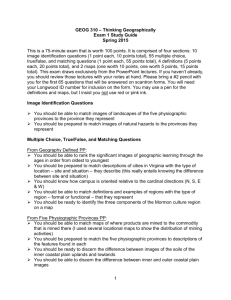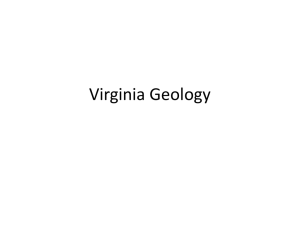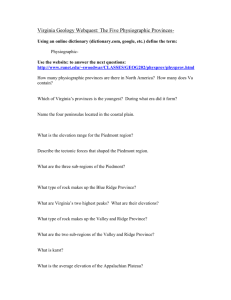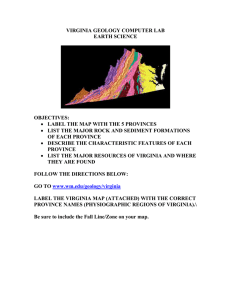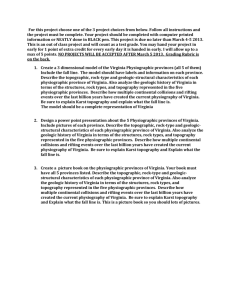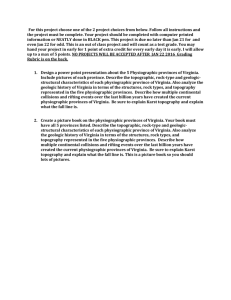Virginia Physiographic Provinces: Earth Science Lesson
advertisement
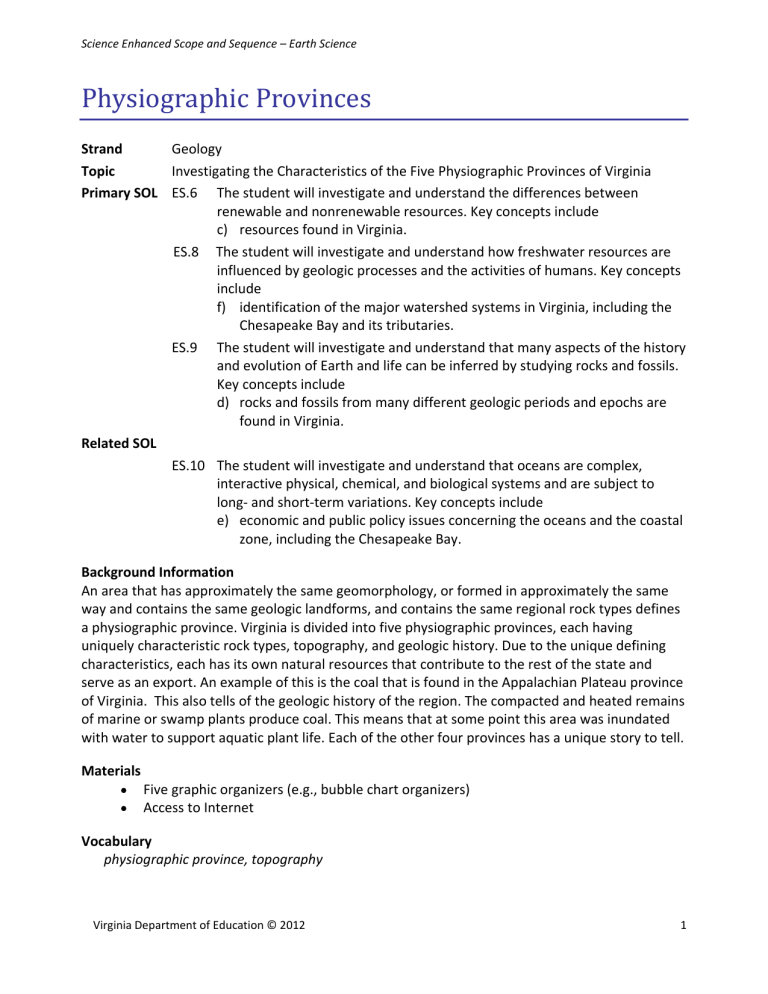
Science Enhanced Scope and Sequence – Earth Science Physiographic Provinces Strand Geology Topic Investigating the Characteristics of the Five Physiographic Provinces of Virginia Primary SOL ES.6 The student will investigate and understand the differences between renewable and nonrenewable resources. Key concepts include c) resources found in Virginia. ES.8 The student will investigate and understand how freshwater resources are influenced by geologic processes and the activities of humans. Key concepts include f) identification of the major watershed systems in Virginia, including the Chesapeake Bay and its tributaries. ES.9 The student will investigate and understand that many aspects of the history and evolution of Earth and life can be inferred by studying rocks and fossils. Key concepts include d) rocks and fossils from many different geologic periods and epochs are found in Virginia. Related SOL ES.10 The student will investigate and understand that oceans are complex, interactive physical, chemical, and biological systems and are subject to long- and short-term variations. Key concepts include e) economic and public policy issues concerning the oceans and the coastal zone, including the Chesapeake Bay. Background Information An area that has approximately the same geomorphology, or formed in approximately the same way and contains the same geologic landforms, and contains the same regional rock types defines a physiographic province. Virginia is divided into five physiographic provinces, each having uniquely characteristic rock types, topography, and geologic history. Due to the unique defining characteristics, each has its own natural resources that contribute to the rest of the state and serve as an export. An example of this is the coal that is found in the Appalachian Plateau province of Virginia. This also tells of the geologic history of the region. The compacted and heated remains of marine or swamp plants produce coal. This means that at some point this area was inundated with water to support aquatic plant life. Each of the other four provinces has a unique story to tell. Materials Five graphic organizers (e.g., bubble chart organizers) Access to Internet Vocabulary physiographic province, topography Virginia Department of Education © 2012 1 Science Enhanced Scope and Sequence – Earth Science Student/Teacher Actions (what students and teachers should be doing to facilitate learning) Introduction 1. As a class, discuss what is known about the state of Virginia. It might be helpful to the students to make a list of the facts and resources that they know about Virginia. This will help to facilitate learning about the individual provinces of VA as the lesson progresses. 2. Have the students who have visited other provinces offer observations they made during their travels. Were there any land forms that they remember from each (mountains, beach, natural bridge, caverns or valley)? Procedure In this activity, students will search the Internet for reliable information to use to create a booklet that details information about the five physiographic provinces of Virginia. Several Virginia institutions of higher education (e.g., James Madison University, the College of William and Mary, Virginia Tech, Radford University) have Web pages providing detailed information on the geology of Virginia and the state’s physiographic provinces. 1. Introduce the five physiographic provinces of Virginia. Have students consult multiple Web sites to gather extensive background information about each one. Check their progress in finding reliable information throughout the activity. 2. Explain to students that the final product of their research will be a booklet with the following required components: Table of Contents Relevant state maps showing the 1) physiographic provinces, 2) watersheds, and 3) geology Minimum of five chapters—one for each of the five physiographic provinces. Each chapter should have the following content: a. Context of the physiographic province within all those of eastern North America b. Well-known cities found in the Coastal Blue Valley Appalachian Content Piedmont Plain Ridge and Ridge Plateau province a c. Topography of the province b d. Watersheds found in the province c d e. Geological history and age of the e province f f. Noteworthy geologic features g found in the province h i g. Rock types found in the province j h. Geologic hazards in the province (e.g., coastal erosion, earthquakes, sinkholes) i. Major fossils found in the province j. Mineral resources found in the province Summary text in the student’s own words Bibliography Virginia Department of Education © 2012 2 Science Enhanced Scope and Sequence – Earth Science Assessment Questions o What are the distinguishing characteristics among Virginia’s provinces? o What are the geologic features found in each and how were these formed? Journal/Writing Prompts o Write a persuasive essay to support which of Virginia’s provinces is most geologically noteworthy. Other o Have students present their booklets in class. Extensions and Connections (for all students) Use the background information collected during the research portion of the lesson to complete the following table. Province Era Period Age Rock Types Coastal Plain Piedmont Blue Ridge Mountains Valley and Ridge Appalachian Plateau Have students use a geographic information system visualization tool to create a map of Virginia that includes the information they collected. Strategies for Differentiation Have students color and label the five physiographic provinces on a map of Virginia. Have students play a game of “Name the Province.” Form four or five student teams. Read aloud a fact pertaining to one of the five provinces, and ask team A to name the province. If team A answers correctly, it gets one point. If it does not answer correctly, ask team B, and then team C, etc. On the next round, start with team B. Have students make an information-organizer foldable: (1) Layer three sheets of paper about 1.25 cm apart vertically. Keep the edges aligned. (2) Fold up the bottom edges of the sheets to form six equal tabs. (3) Crease the fold well to hold the tabs in place, and staple along the fold. Starting with the top tab, label the tabs as follows: Coastal Plain (including the Fall Zone), Piedmont, Blue Ridge, Valley and Ridge, and Appalachian Plateau. Have the students plan a road trip that includes a single stop to see a natural attraction in VA. Virginia Department of Education © 2012 3
